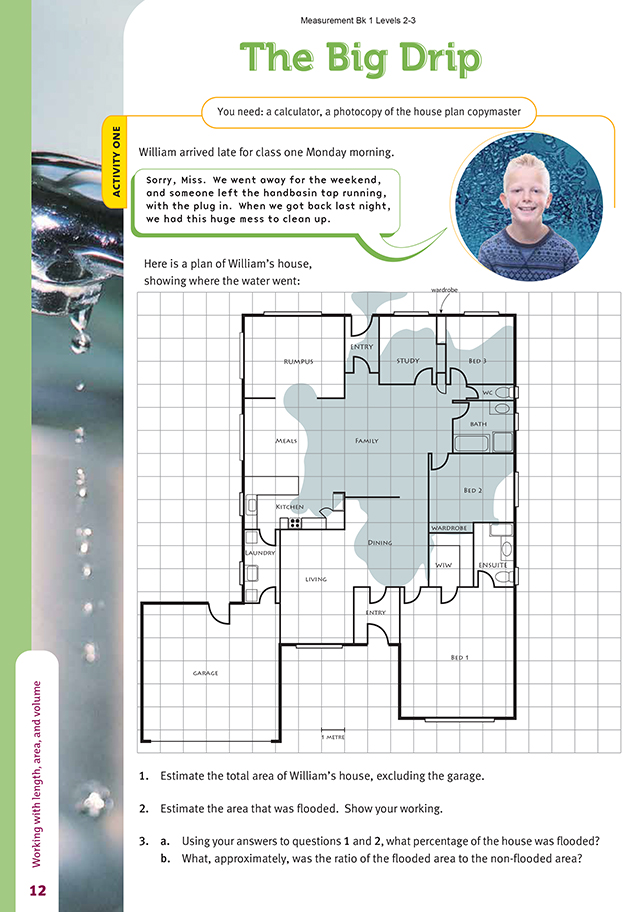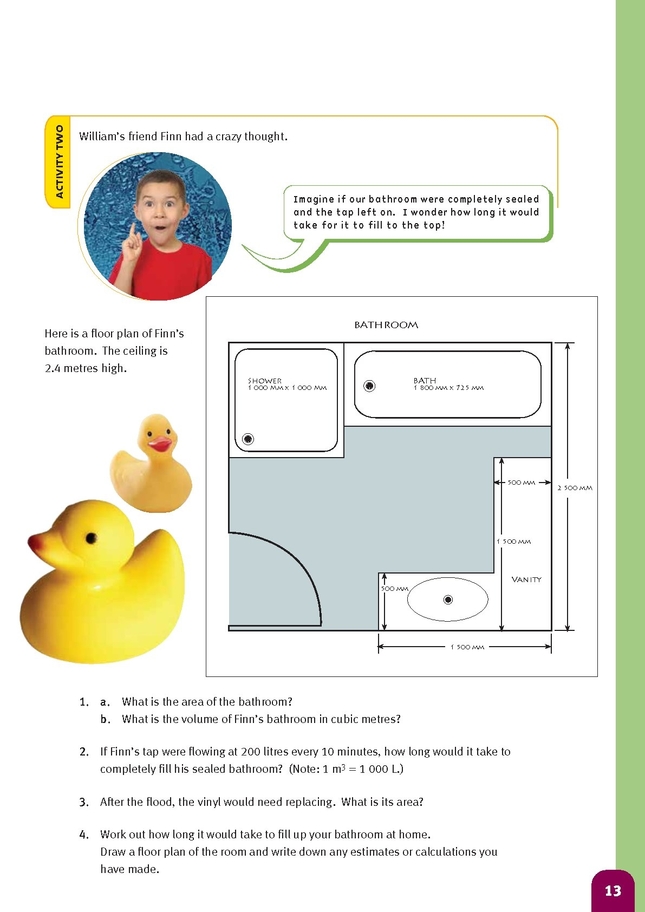The Big Drip
This is a level 4 measurement strand activity from the Figure It Out series.
A PDF of the student activity is included.
Click on the image to enlarge it. Click again to close. Download PDF (234 KB)
find the area and the volume
calculator
FIO, Level 4+, Measurement, Book Two, The Big Drip, pages 12- 13
Copymaster of house plan
In these activities, the students work with area and volume based on scale diagrams. They also use percentages, ratios, and rates.
Activity One
Questions 1 and 2 are similar to the questions in Pounamu Pendants (page 10 of the students' book). The students estimate the area of a composite shape by counting squares. Each square conveniently represents 1 square metre. Two ways of dealing with part squares are discussed in the notes for Pounamu Pendants.
Question 1 asks the students to exclude the area of the garage in their calculations. Some may not notice this instruction.
In question 3, the students use the areas they calculated in questions 1 and 2 to work out a percentage and a ratio. Before they enter values into their calculators, they should note that, very roughly, half the house (excluding the garage) has been flooded, so they should get a result that is somewhere around 50 percent.
If they then divide the total area by the flooded area and get an answer such as 240 percent, they should realise that they have made a mistake.
Question 3b is not simply a matter of converting a percentage (question 3a) into a ratio. In this case, the students are comparing the flooded area to the non-flooded area, not the total area. Encourage them to look for a simple ratio (as in the Answers) that is a good approximation.
Activity Two
When doing question 1, the students should convert all measurements to metres and give their answers in square metres and cubic metres. This will avoid large numbers of zeros and reduce the risk of putting a decimal point in the wrong place.
Question 2 is best done using hours rather than minutes. The first step is to work out how much water would enter the room in an hour. The next step is to divide the volume of the room by the volume of water that would enter in an hour. Some students may need to be talked through this relationship.
The students can solve question 3 by taking the area of the room and subtracting the area of each of the fittings. Alternatively, they can divide the irregular shape of the vinyl into various rectangles, find their areas, and then add them together.
In question 4, the students measure their own bathroom and draw a plan of it. They could make their measurements accurate to the nearest centimetre. They will need to use a suitable scale: 10 centimetres to 1 metre may be suitable for a small bathroom, 5 centimetres to 1 metre for a larger bathroom. They should write down their estimates and calculations in an orderly way so that others can understand what they are doing.
Answers to Activity
Activity One
1. Answers will vary but should be close to 183 m 2.
2. Answers will vary but should be in the range 74 -78 m2. 76 m2 is a good estimate. Your markings on your copy of the copymaster should show how you reached your answer.
3. a. Answers will vary, depending on your answers for questions 1 and 2. If an area of 76 m2 is flooded, this is 42% of 183 m2, to the nearest whole percent.
b. Approximately 2:3. (If 42% is flooded, 58% is not. As a ratio, this is 42:58, which is approximately 40:60 or 2:3.)
Activity Two
1. a. 7 m2. (2.8 x 2.5)
b. 16.8 m3. (2.8 x 2.5 x 2.4). The fact that the room contains a vanity, bath, and shower will make little difference; water will occupy their spaces too.
2. 14 hrs. (At 200 L every 10 minutes, the water is coming in at the rate of 1 200 L every 60 minutes.
1 200 L is equivalent to 1.2 m3. The time taken in hours for the room to fill is:
volume of room ÷ rate per hour = 16.8 ÷ 1.2 = 14 hrs.)
3. 3.45 m2
4. Individual activity. Answers will vary.

